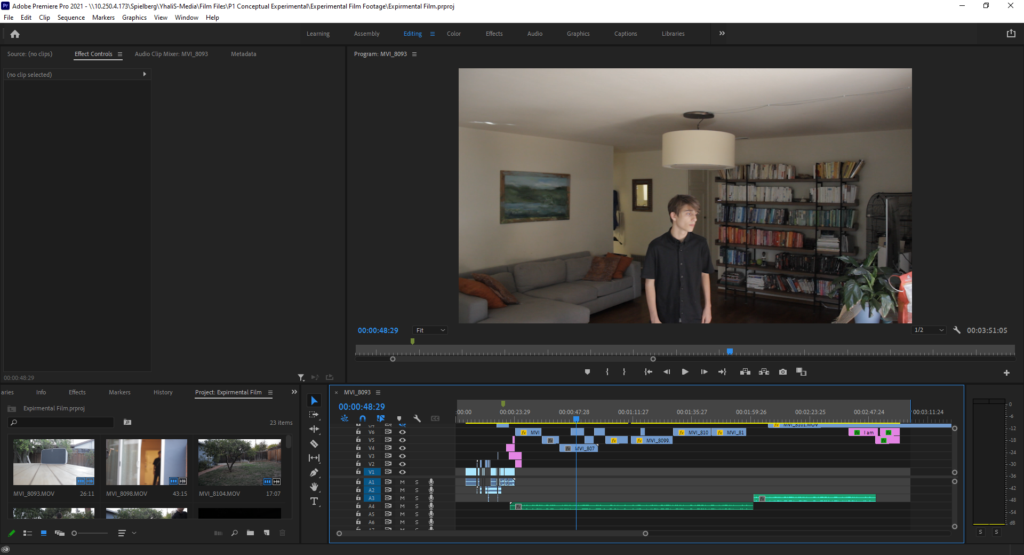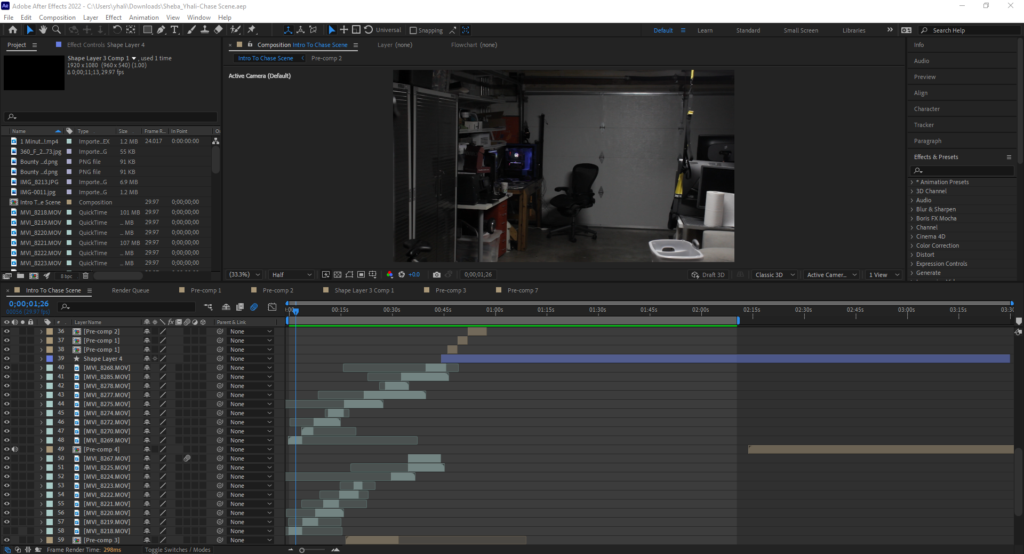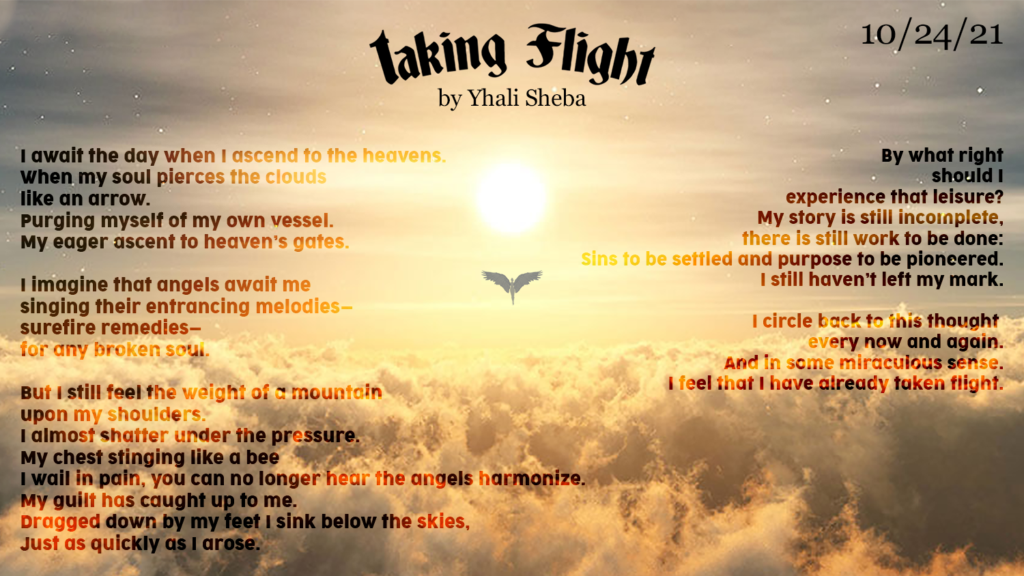Introduction
“How can I use unconventional forms to express myself?”
Throughout the conceptual unit, we were challenged to explore creativity and abstract thinking and express ourselves through different mediums of art such as poetry, music, art, animations, experimental film, and web production. Through learning how to use equipment and applications such as DSLR cameras, Tascam Audio Recorders Adobe Photoshop, Adobe Animate, Adobe Premiere Pro, Adobe After Effects, Adobe Audition, Avid Pro Tools, WordPress, and Google Apps, I was able to broaden my horizons for technical communication.
I valued the opportunity to learn how to use all of these professional applications, as doing so broadened my skillset and introduced me to new means of communication that I wasn’t previously familiar with. In English, I appreciated how the class was oriented more around storytelling than standard essay writing, I feel like the class helped me develop much more imperative communication skills that will help me become unstoppable in the future. The conceptual unit had us delve into unknown territories and think out of the box, and while it was intimidating at first, it taught me how to explore my ideas through unordinary means and instilled the valuable lesson:
“Show don’t tell”.
Haikus
Brevity is the soul of wit. We started our conceptual unit at Freestyle by creating Haikus, where we expressed complex thoughts and emotions while being limited to only three lines with five, seven, and five syllables. Working with these constrictions created some unique writings, and when complemented with our own matching photos to offer visual comprehension, it created very captivating artworks.
Behind the Scenes

I truly valued the Haiku project because working with a restricted canvas encourages creative thinking and effective communication. The video production was especially exciting as I was able to see my work come to life.
Poetry
Poetry allowed us to expand on the same ideas from the Haiku project, except this time we weren’t constricted by syllables, giving a lot more creative freedom. We brainstormed and created our poems in our English class and then transferred the finished work into Digital Media where we introduced visual artwork to enhance the poetry.
“Taking Flight is a free verse poem about the complexities of the afterlife, specifically focused on how we as humans separate our soul/spirit from our physical beings and sometimes ponder on the possibilities of where we go after we die, and is inspired both by notions of religion as well as my own personal beliefs/experiences. The speaker in this poem is a young adult, whose is supposed to embody myself. I tried to portray them as someone who has gained self-consciousness and has an advanced thought process, but more notably, is an overthinker. Throughout the poem, they contemplate their fate in the afterlife, but their thoughts ultimately come full circle when they realize that it is too early to ponder on such thoughts when their life is still so unfulfilled, thinking in the long term. In the first stanza, I use a simile to compare the soul’s ascent to the afterlife to an arrow piercing through the sky, resorting to figurative language as a means of conveying the beauty of death. Additionally, I mention the “golden gates” as a form of visual imagery which alludes to heaven. In the second stanza, I utilized alliteration to make the poem more catchy, thus enhancing the enjoyment of the reader. I also strategically put an end-stop after each line to offer a moment of contemplation in between sentences but also to make the poem more pleasurable to read. Ultimately, the poem’s slow pacing pattern allows the reader to almost experience the writer’s thoughts alongside them. During peer review (I was only able to do the first one), my readers enjoyed the usage of figurative language but suggested that I use a variation of enjambed and end-stop lines to enhance the reading experience of the poem. I adjusted the sentence structure to include a variation of end-stopped while also including some enjambed lines when appropriate in order to improve on the way that the reader experiences the poem. The lines containing a variety of periods, commas, and en-dashes, offer different intervals of pause in between lines giving the poem brevity when necessary and dragging the poem out where the reader was supposed to evaluate and comprehend more complex ideas. When making this poem, I was particularly inspired by the Jewish religion, to which I conform, because the Torah (Jewish sacred book) provides unique insights into the afterlife and other begins/ideas that transcend above human life. The use of diction and figurative language was a testimony to the concept of the afterlife and human existence as captured in the Torah (I attempted to emulate the complex language in my poetry).”
When reflecting on the poetry unit, I am truly appreciative that I was able to use our advanced equipment and software such as pro-tools to produce a high-quality visual and audio representation of my work. The image of the angel ascending to the clouds, which I produced for this poem, is by far my favorite design thus far.
Audio Production

Visual Production

Photoshop: Blend Modes
During our photoshop unit, we learned how to use blend modes in order to adjust images so that they look better. We learned how different blend modes such as lighten, darken and overlay influence the colors of an image and how we can use them precisely to improve photos.
I think that photoshop blend modes are a super creative way to enhance the quality of photos to make some super unique artwork. I already knew about blend modes because of my graphic design background but I valued that we were taught how the different modes are categorized and how they work based on black, white, and colors in between.
FIlm PRODUCTION
For our conceptual unit in film, we began by learning how to use professional camera equipment and editing software and jumped headfirst into making projects, where our goal was to learn the fundamentals basics of film language, aiming to communicate emotion and intrigue our audience through a two-dimensional canvas.
I valued how we were taught everything from the logistics behind filmmaking to the industry standards and expectations, training us well for the industry and pushing me to create work that I am proud of.
The highlight of our conceptual unit was the experimental film in which every student was given a unique concept statement that explores an emotion through action. We then had to interpret these intention statements and conceptualize a film that captured those emotions in an arbitrary way.
The Frolic – Behind the scenes
“I am exploring the feeling of love through asking someone to dance.”
For my experimental film, I wanted to have a group of people (the same person) dancing in a white vague room, with random objects scattered around the room. The dance moves are very obscure in a similar way to how Joaquin Phoenix dances in the movie The Joker. The people will all be dancing in one group, with there being one outlier that tries to join them, but they all avoid him and move away when he approaches. Over time, more people from the group will disappear, until the only one dancing is the lone individual, at which point he stops dancing, and hugs himself. The film is supposed to represent how sometimes we are too caught up with trying to be someone we’re not, and you need to embrace and love yourself before you can love anyone else. The hug at the end is supposed to be somewhat eerie, but it captures the embracement and love of oneself.
The Frolic was made over a three-week period. During the first week, I pitched my original concept to the class to recieve critiques, creating the final version for the film as seen in the synopsis above. During the second week, I did all the filming with the help of freestyle student Eric Shachal. And lastly, during the third and final week, I composed the film in Adobe Premiere Pro. This proved to be the most challenging part of the process as it required the most attention to detail and creativity.
Overall, I am super thrilled with how the film turned out and I think that it closely captures and balances the feelings of despair and love that I was going for. I think that the film also conveys a very powerful message about how you need to embrace and accept yourself before you can love others.

Chase Scene – Bounty Board
Among the other projects from the conceptual unit, the chase scene was really unique. To practice filmmaking techniques such as Griffith’s Pattern, students had two weeks to film a creative chase scene that showcased the proper usage of different camera shots to tell a story and convey emotion from the characters.












